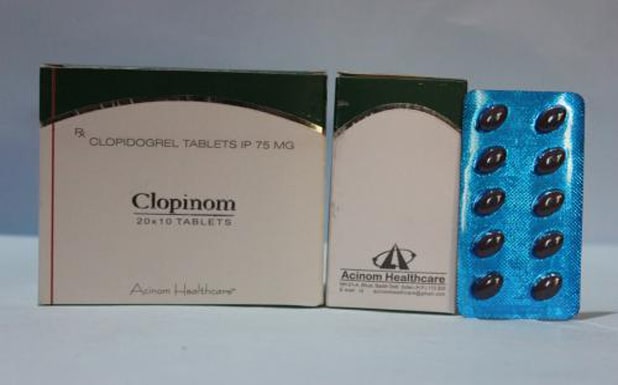The medication comes in the form of a tablet which is taken by mouth Clopidogrel oral tablet is also available as the brand-name Plavix. It’s also available as a generic drug. Clopidogrel can be used as part of a combination therapy, which means you may need to take it with other drugs. This is decided by the doctor only.
Clopidogrel is also used with aspirin to treat worsening chest pain , unstable angina and to keep blood vessels open and prevent blood clots after certain procedures such as cardiac stent and provides additional benefit to patients with acute coronary syndromes already taking aspirin.
About Composition:
Clopidogrel is mainly used to prevent heart attack and stroke in people who are at high risk of these events, including those with a history of myocardial infarction and other forms of acute coronary syndrome, stroke, and those with peripheral artery disease. Clopidogrel's is also beneficial in those who smoke cigarettes with only slight (8%) benefit in those who do not smoke cigarettes.
Clopidogrel is indicated in:
- ischaemic stroke (from 7 days until less than 6 months) or established peripheral arterial disease.
- Prevention of atherothrombotic and thromboembolic events in atrial fibrillation
- Adult patients suffering from acute coronary syndrome
Mechanism of Action:
Clopidogrel is known as a prodrug, which is activated in two steps: by CYP2C19, CYP1A2 and CYP2B6, then by CYP2C19, CYP2C9, CYP2B6 and CYP3A. The active metabolite then specifically and irreversibly inhibits the P2Y12 subtype of ADP receptor, which is the main key factor in activation of platelets and eventual cross-linking by the protein fibrin. Platelet inhibition can be demonstrated two hours after a single dose of oral clopidogrel, somehow the onset of action is slow, so a loading dose of either 600 or 300 mg is administered when a rapid effect is needed.
Clopidogrel is metabolized to its active form by carboxylesterase-1. This binding prevents ADP binding to P2Y12 receptors, activation of the glycoprotein GPIIb/IIIa complex, and platelet aggregation.
Pharmacodynamics:
Clopidogrel is a prodrug of a platelet inhibitor which is used to reduce the risk of myocardial infarction and stroke. It is taken once daily and has a long duration of action and a large therapeutic window as it is given in doses of 75-300mg daily. Clopidogrel is metabolized by CYP450 enzymes to produce the active metabolite that inhibits platelet aggregation. Repeated doses of 75 mg Plavix per day inhibit ADP-induced platelet aggregation on the first day, and between day 3 and day 7 inhibition reaches steady state.
Pharmacokinetics:
Metabolism and elimination: In vitro and in vivo, clopidogrel undergoes rapid hydrolysis into its carboxylic acid derivative. In plasma and urine, the glucuronide of the carboxylic acid derivative is also observed.
Absorption:A 75mg oral dose of clopidogrel is 50% absorbed by the intestine. We can take clopidogrel with or without food. A meal decreases the AUC of the active metabolite by 57%. The active metabolite of clopidogrel reaches a maximum concentration after 30-60 minutes.Clopidogrel reached a Cmax of 2.04±2.0ng/mL in 1.40±1.07h.
Protein binding: Both the active and inactive metabolites of clopidogrel are 98% protein bound in plasma. Some studies in cows show clopidogrel 71-85.5% bound to serum albumin.
Volume of Distribution: The apparent volume of distribution of clopidogrel is 39,240±33,520L
Metabolism: 85-90% of an oral dose undergoes first pass metabolism by carboxylesterase 1 in the liver to an inactive carboxylic acid metabolite , about 2% of clopidogrel is oxidized to 2-oxoclopidogrel. This conversion is 35.8% by CYP1A2, 19.4% by CYP2B6, and 44.9% by CYP2C19 though other studies suggest CYP3A4, CYP3A5, and CYP2C9 also contribute. 2-oxoclopidogrel is further metabolized to the active metabolite.
Route of Elimination: An oral dose of radiolabelled clopidogrel is excreted 50% in the urine and 46% in the feces over 5 days. The remainder of clopidogrel is irreversibly bound to platelets for their lifetime, or approximately 8-11 days.
Side Effects:
- Upper respiratory tract infection
- Chest pain
- Headache
- Flulike syndrome
- Joint pain, Pain
- Dizziness
- Diarrhea
- Rash
- Runny or stuffy nose
- Depression
- Urinary tract infection
- Increased bleeding,Nosebleeds
- Itching, Bruising
Contraindications:
- Severe hepatic impairment.
- Active pathological bleeding such as peptic ulcer or intracranial haemorrhage.
Pregnancy:Clopidogrel is not preferable during pregnancy as a precautionary measure and also not during breast-feeding.
